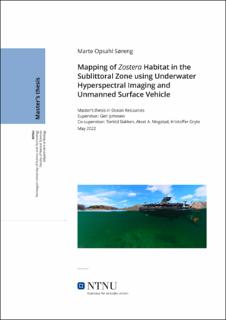| dc.description.abstract | Sjøgressenger over hele verden trues av menneskeskapte habitatødeleggelser og global oppvarming. Det er et behov for kartlegging med høy oppløsning for å øke overvåkningsevnene våre og fylle kunnskapshull knyttet til disse sårbare og grunne kystøkosystemene. I denne studien blir en undervanns-hyperspektral avbilder (UHI) båret av et ubemannet overflatefartøy (USV) for å kartlegge sesongvariasjoner av romlig fordeling av marin vegetasjon (sjøgress og makroalger) i et Zostera habitat i Hopavågen, en nesten lukket våg i Agdenes, Norge. UHI-en muliggjør en artsspesifikk identifisering basert på den karakteristiske pigmentsammensetningen til en organisme av interesse (OOI). Dette innebærer at en spektral reflektanskurve (også kalt optisk signatur) blir registrert av sensoren og tilegnet hver bildepiksel med en rommlig oppløsning på 1 cm2, og en spektral oppløsning på 2.2 nm. Tre transektlinjer fra september, desember og februar ble kjørt med UHI-en ~1.6 m over området av interesse på havbunnen.
Etter georeferering, radiometrisk prosessering og radians-konvertering av UHI-dataen, ble den marine vegetasjonen identifisert ved hjelp av Support Vector Machine (SVM), som er en veiledet klassifiseringsalgoritme. På denne måten ble utbredelseskart over OOIene lagd og dekningsgrad i prosent ble beregnet. I tillegg ble SVM-klassifiseringen sammenlignet med Band Ratio- og Decision Tree-klassifiseringer. Effektiviteten og påliteligheten til denne kartleggingsteknikken ble vurdert ved hjelp av klassifiseringsnøyaktigheten, tidsbruk og evnen til å gjenbesøke samme område. Trådalger (trådlignende epifyttiske alger) er en stor trussel mot sjøgresshelse og vokser raskt hvis det er eutrofiering i et område. Derfor undersøkte denne studien også potensialet for å oppdage og kvantifisere trådalgevekst, men mer arbeid trengs for å kunne separere brune makroalgearter med sikkerhet.
SVM-klassifiseringen klarte å skille sjøgress fra makroalger, men i varierende grad avhengig av pre-prosesseringen og kvaliteten til UHI-dataen. Innfallende spektral irradians (innstrålingstetthet) og sjøvannets iboende optiske egenskaper spiller en essensiell rolle i signal-til-støy-forholdet i dataen, og påvirker korrekt klassifisering. På grunn av dette blir Band Ratio-klassifiseringen vurdert som den mest pålitelige og tidseffektive klassifiseringsalgoritmen for sjøgresskartlegging i ulike sesonger, gitt forholdene som var til stede her. Ved å bruke det karakteristiske reflektansmaksimumet ved 550 nm og reflektansminimumet ved 665 nm var det mulig å trekke ut informasjon om fordelingen av fotosyntetiserende biomasse som absorberer bølgelengder av lys som sammenfaller med klorofyll a og b. Vissent sjøgress hadde lignende optisk signatur som brunalger, og dette må tas høyde for under tolkning av klassifiseringsresultatene. Små trådalger var også vanskelig å klassifisere med sikkerhet.
Ved å demonstrere USV-UHI-basert kartlegging er studien et bidrag til å etablere og validere ulike metoder for å samle og ekstrahere viktig økologisk informasjon fra UHI-data. Denne informasjonen kan videre brukes i sjøgressforskningen og være nyttig for økosystemforvaltning og konservering de neste årene. | |
| dc.description.abstract | Seagrass meadows around the world are threatened by anthropogenic activity, causing habitat destruction and global warming. There is a need for better high-resolution mapping to increase monitoring abilities and fill knowledge gaps regarding these vulnerable shallow coastal ecosystems. In this study, an underwater hyperspectral imager (UHI) was deployed by an unmanned surface vehicle (USV) to map spatial and seasonal distribution of marine vegetation (seagrass and macroalgae) in a Zostera (eelgrass) habitat in Hopavågen, a semi-enclosed bay in Agdenes, Norway. The UHI enables species-specific identification based on characteristic pigment composition of the organism of interest (OOI), resulting in a spectral reflectance curve (i.e. optical signature) detected by the sensor, and obtained in each image pixel with spatial resolution of 1 cm2 and spectral resolution of 2.2 nm. Three transect lines from September, December and February were recorded with an altitude of ~1.6 m above the area of interest on the seafloor.
After the georeferencing, radiometric processing and radiance conversion of the UHI data, the marine vegetation was identified using the supervised classification algorithm Support Vector Machine (SVM) in order to create distribution maps and estimate percent areal coverage of the OOIs. Additionally, the SVM-classifier was compared to Band Ratio and Decision Tree classifications. The efficiency and reliability of this mapping technique were assessed by looking at the classification accuracy, time use and the ability to revisit the same location. Since turf algae (filamentous epiphytic algae) is a major threat to seagrass health and grows rapidly due to eutrophication, the study also investigated the potential for detection and quantification of turf algae growth, but further work is needed to separate specific brown macroalgae species with confidence.
The SVM classification successfully separated seagrass from macroalgae, but performed differently according to the pre-processing and quality of the UHI data. Downwelling spectral irradiance and inherent optical properties of the seawater play an essential role in the signal-to-noise ratio, influencing correct classification. Thus, the Band Ratio classification is considered to be the most reliable and time efficient classifier for seagrass mapping in different seasons, under the conditions outlined by this thesis, using the characteristic reflectance maximum at 550 nm and reflectance minimum at 665 nm to extract information of the distribution of photosynthesizing biomass absorbing wavelengths corresponding to Chlorophyll a and b. However, withered seagrass was found to have a similar optical signature as brown algae, and this must be kept in mind when interpreting the classification results. Turf algae of small sizes were also difficult to classify with confidence.
By demonstrating USV-based UHI mapping, the study is a contribution to establish and validate different methods for acquiring and translating UHI data into ecologically important information, which can be applied to seagrass research and aid ecosystem management and conservation in the upcoming years. | |
